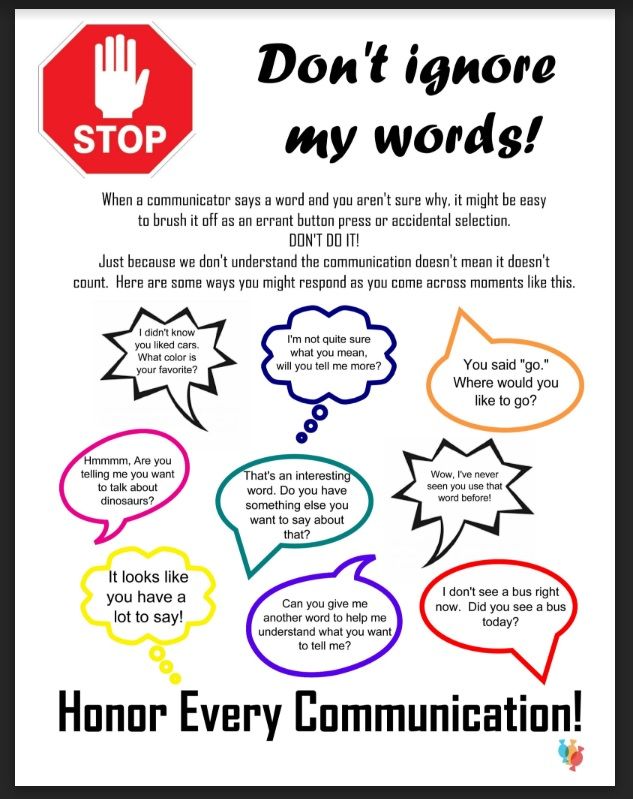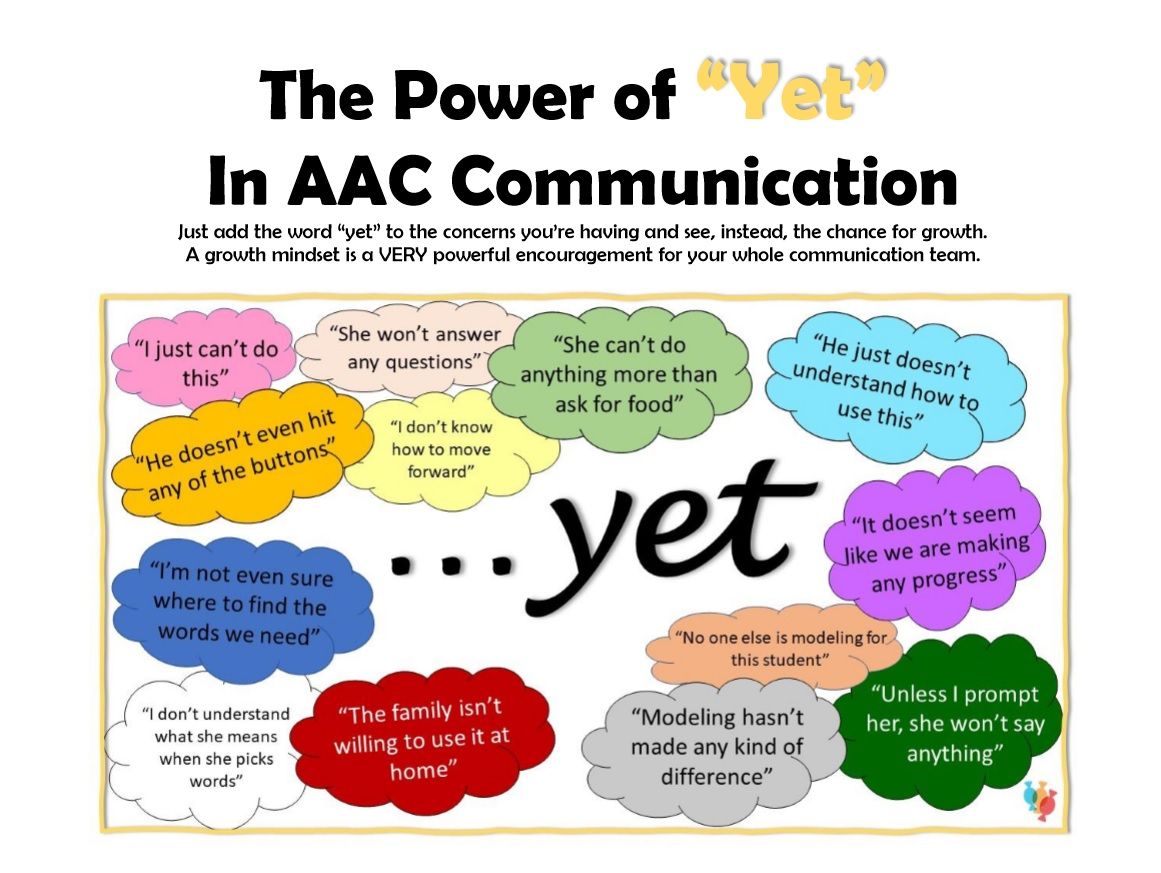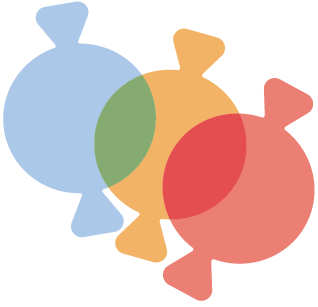Choosing Empowering Language: Words that invite AAC users to grow & be heard
Interactions are powerful human moments. When we rub shoulders with another person (literally or fuguratively) we have the chance to influence the way that person percieves themself and the world around them.
When working with and around AAC communicators, the language we use and the ways we engage create the lens through which communications are viewed. The structure of our message sets the tone for not only that individual interaction but also the way communicators and supporters view AAC communication.
What message do we present if we overlook or override a person's attempts to communicate?
If we dismiss a person's words saying, "Oh, that didn't mean anything, just ignore it" or "They're just pressing random buttons, you don't need to listen to that" what are we teaching our communicators, their peers, and members of the communication team?
Learning to use AAC to speak IS learning a new language. It takes time and a lot of work. If we reject a person's words after they have made the effort to share them, what message do you think they will receive?
- "No one cares what I say."
- "My words only matter if they match what my teacher wants to hear."
- "I am not of value, my message doesn't count."
- "People only have to accept my words if they want to."
- "No one listens to me anyway, why should I try to learn this method of communication?"
We cannot let those things be true.
Why would a person make the effort to communicate, using ANY platform, if they are taught by the actions of those around them that their message has such little worth?
But, let's not be a "Debbie Downer" about all of this. We aren't powerless here. We can change the momentum of these moments of expression.
What does that look like?
How can we use our words to build on rather than tear down a person's seemingly errant communication attempts?
After all, it's true that as a person is learning to use AAC they will probably have some accidental button presses, they may do some exploring and hit random words, and they will likely say things that seem to make no sense in the current context.
When (not if) these things happen, how can we empower AAC users and motivate confident communication rather than dismissing or devaluing the message?
Here are three important reminders to help communicators thrive.
1. Choose to see the person first
Communication is about connection. No matter who you are or how you vocalize your thoughts, needs, and feelings the real reason we communicate is to connect with the people around us.
When we choose to recognize that the words we hear and the messages shared represent an actual person, not just a string of letters for language, we are more likely to respond in a way that encourages and strengthens our link to that person. We are also more likely to acknowledge them as valuable, unique, intelligent individuals rather than beings who put random words out into the world.
We can use our words to dispel unenlightened ideas and blot out negative labels so that others surrounding a communicator see the person behind the device. The way we speak about a communicator affects the way others view and define them and the way communicators may characterize themselves. If we focus solely on problems or plans, we may lead others to treat this communicator like a project rather than a person.
Every person has a voice. Every person deserves to be heard, and AAC helps to make that possible. Let's not forget that there is a person behind those button presses and connecting with them is what matters most.

2. Honor EVERY Communication Attempt
It's true, sometimes an AAC user presses buttons that seem irrelevant or unrelated to the setting. In those circumstances, it would be easy to blow by the message or move on to something else. After all, the message didn't make sense or fit with the situation.
But who are we to determine what is in the mind of another person? What if they MEANT to say that word? What if there IS a message they are trying to share? Just because we don't understand perfectly, doesn't mean the words are not valid.
Make a habit of answering every vocal venture students make. It can be simple and easy. Even if you don't understand their full message, you can acknowledge and affirm the fact that something was said.
- "Wow, I haven't heard you say that word before."
- "I see you said 'play' but right now we are doing math, will you help us solve this problem?"
- "I like that too!"
- "I don't see that right now, but maybe when we go outside later."
- "Can you tell me a bit more, I'm not sure I understand?"
It doesn't matter exactly what they say, especially at first. The power comes from validating their voice. More meaningful messages will develop as a person realizes we are striving to assign intent to their speech.
This also means that if a person clearly communicates a message without using AAC (makes an angry face, points to something they want, etc) we acknowledge and accept that message. We don't say, "First, show me on your device" or something similar. We can expand on the message, ("Oh, your face tells me you don't like that, is that right, are you 'angry' ") and model words from the AAC system to support the conversation, but we demonstrate that we care about the person and their message by embracing what they share.
When we demonstrate that we are listening, even if we don't completely catch the full meaning or it isn't voiced with the device, we teach AAC users some important lessons.
- We illustrate that their words should not be ignored.
- We verify that we see meaning in the words they say.
- We show them and others that AAC is as valid a form of communication as verbal speech.
- We convey that their message matters no matter how they say it.
- But maybe most importantly, we reveal to them that we see their value and we have a desire to connect and get to know who they really are.

3. Maintain a Growth Mindset for Communicators
If we speak about AAC communication as though it is lesser or AAC communicators as though they are a problem to be dealt with, we are confining them unfairly and limiting progress. To label a person or communication modality as "not as good" in one way or another taints the perception of anyone who interacts with AAC or its users. It impairs their abilities and hobbles their opportunities.
If instead, we decide that every person has the ability to grow even if that growth looks a little bit different for them than most, we open up a world of possibilities. Who knows what a person can accomplish when given the chance!
Choose to empower communicators and teams. Be their biggest cheerleader! Speak directly to communicators. Demonstrate that AAC is valid by modeling words in many situations, not just when you speak to the AAC user. Never insinuate that an AAC user is less than or incapable just because they need to do something in a different way than most. Remember that learning to speak with AAC is learning a new language, that is not an easy thing to do. Smile. High five. See the good. Look for the growth and let people know you see it, it's there even when it's small.
Capable, confident, empowered communicators do not just happen by chance. They emerge when their environment allows for acceptance, exploration of new ideas, recognizing mistakes as chances for learning, and most importantly knowing that they are sincerely seen, heard, and wanted.

While every AAC communication instance may not ring with perfection (in fact, that's pretty much impossible) when we reach for the ideal we'll make headway toward the objective. Step by step we get a little better and a little better and together with our communicators, we move toward intentional, robust communication – the kind of communication that empowers not just AAC users but everyone with whom we (and they) engage.
That's a powerful thing.
